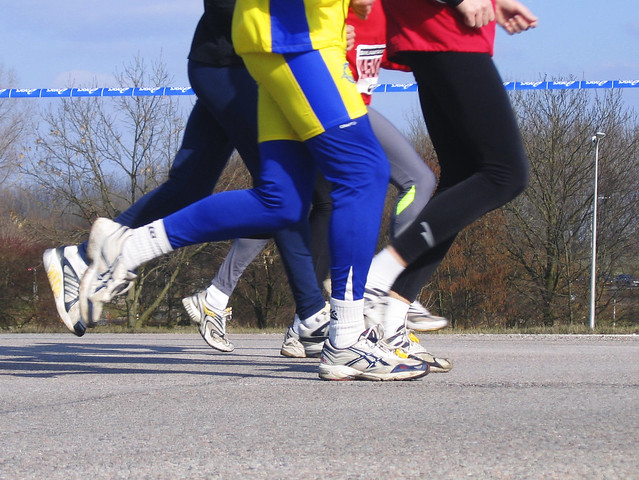In the little coffee house church in D.C. where Daniel and I met, I once gave a sermon focused on my experience as a person with a disability, in which I said that I sometimes feel “betrayed” by my body because its limitations can keep me from doing things I desperately want, even need, to do. After the sermon, we shared a simple meal of bread, cheese, fruit, coffee, and tea around tables while discussing the sermon (the leftover bread would be blessed and used in the Eucharist to come). At my table, a friend said that she couldn’t get on board with the idea of a body betraying a person, because to her, the body and the person are one. The body isn’t just some material vessel that works at odds to the internal and invisible spirit. The body, rather, is as much part of the person as are the emotions, the psyche, and the spirit.

At the time, I felt that my friend was just wrong. She not only didn’t get what I was saying, she couldn’t get it. She, after all, had a body that had always done exactly as she wanted and needed it to do. She was (still is) tiny, all muscle and sinew. She and several other friends belonged to that baffling cohort of people for whom distance running and other athletic feats engender feelings of freedom, rather than fatigue, pain, and a desperate longing for couches and quilts. In his new book This is My Body: From Obesity to Ironman, My Journey into the True Meaning of Flesh, Spirit, and Deeper Faith, Ragan Sutterfield (currently an Episcopal seminarian at Virginia Theological Seminary), describes what happens to him when he pushes his body in long-distance races:
Why did I want to become an Ironman? Because I wanted to experience even more deeply what I had experienced before in endurance races: a kind of radical presence, a focus and attention unlike anything else, a full integration of myself that was purely here and now but also outside of the normal feeling of time. What I’m describing is something known as “flow.” Flow, this integration of everything in a single moment, is a rare thing. Many people experience something similar when writing, when reading, even when praying. In those moments, time seems to change and everything disappears into the now—no future, no past, just this present moment.
I can understand how, if you’ve ever experienced what Sutterfield describes as a result of pushing your body, it would be hard to accept the idea of one’s body as a betrayer, at odds with one’s true self. For me, though, pushing my body is unlikely to result in “flow.” Pushing my body is likely to just leave me in more pain. My body’s problems make it impossible for my body to become integrated with mind and spirit as Sutterfield describes.
Living with physical limitations and pain often feels like living with another entity —a particularly sensitive and demanding twin perhaps, always ready to step in to tell me that our plans will have to change because she doesn’t feel up to them. For many of us living with chronic conditions or experiencing acute health crises, it can feel that our bodies don’t really belong to us, that they are captive to forces over which we have little control—fatigue, pain, medication, procedures, our caregivers’ schedules and priorities. That’s why I spoke in the language of bodily “betrayal” even 20 years ago when I was far more fit and capable than I am today.
Today, I believe that both I and my friend got it right that night when I spoke of bodily betrayals and she wasn’t buying it. I think our bodies can indeed betray us, their broken places (whatever they may be, from chronic conditions, acute illnesses and eating disorders to struggles with weight, body image and gender norms that don’t match one’s inner landscape) creating real barriers to the abundant life God desires for us. I also think our bodies are such an integral part of who we are, in the deepest sense, that our bodily experiences are part of our authentic self, not separate. We live with a bodily paradox—bodies are limited and limiting potential betrayers, and they are an inseparable part of who we are in the fullest sense.
Christianity makes human bodies central to the story of salvation. In Jesus, God experienced the limits and travails of having a human body, including the most brutal death, along with bodily pleasures, such as eating and drinking with friends. In our creed, we say we believe in the “resurrection of the body.” Christianity insists that salvation happens not in spite of our bodies with all of their brokenness and mess, their possibilities and pleasures, but in, through and with our bodies.
And yet, through much of our history, Christians have adopted a view of the human body that is more Greek than Christian, dividing body from spirit and elevating the latter over the former. In this view, the body is merely a vessel—often a shameful, wayward vessel—for a pure spirit. Many heresies have come from this view of a sinful body paired with a transcendent spirit. The Gnostics of early Christian history saw the body as so shame-filled and problematic that they insisted that Jesus could not have been fully human. Privileged people benefiting from the mistreatment and labor of less privileged people have cloaked their complacency in a “pie in the sky” theology, whereby today’s suffering will pale in comparison to the rewards of heaven, when people’s spirits, separated from their pesky bodies, will soar free. Recent movements popular in evangelical Christianity, such as “purity” pledges and courtship rituals in which couples don’t even hold hands or kiss before their wedding day, arise from a deeply divided theology, whereby the troublesome body and its sinful desires stand ever-ready to derail the spirit’s reaching toward God and must therefore be tightly controlled.
As Sutterfield writes in This is My Body, such Gnostic/divided theologies fool us into believing that “God’s purpose…was not to make the world holy but to rescue his people from the world. That is not the Christian story; like us, God has a body…Gnosticism…is about bodies without story or soul.”
My Episcopal/Anglican tradition takes bodies seriously by practicing rituals that incorporate our bodies. When we kneel or stand for prayers, our change of position signals that we are doing something important, even if our minds aren’t entirely engaged. The Eucharist—the physical act of eating together—is the culmination of our service every week. As Sutterfield says about communion:
What helped me hold on [to faith] was the Eucharist, taking it in as often as I could, staying with it regardless of what I felt, eating the body of Christ again and again so that Christ was within me. Even if I didn’t feel him close, he was close. Even if I couldn’t believe in him at times, I could at least taste him…We cannot always feel our faith. We cannot always know it. We cannot always possess it. These are, after all, the wrong hopes. This is why we need a body to hold onto. That is why we need a God we can eat—to remind us of the real object of our hunger.
Sutterfield’s This is My Body is one of several new books about putting the human body back at the center of Christian theology and practice, where it belongs. As someone whose faith has always been complicated by my life with a literally broken body, I’m grateful for this trend—and a little frustrated that these books largely reflect the experience of people with bodies that are healthy save for an occasional crisis, bodies that can be trained and improved with exercise and diet. Meanwhile, I currently have a stress fracture in my femur that happened when I took the oh-so-radical step of trying to improve my health and stamina via a daily walk with my dog. There will be no revelations for me in pushing my body to or beyond its limits; there will only be greater injury.
I go back to that long-ago sermon I preached, to the paradox that our bodies both betray us and reflect our deepest, God-given self. I think of the broken, brutalized body of Christ on the cross, as he suffered through pain that was both horrific—a reflection of all that is wrong with this world—and redeemed—a means for God’s grace to be revealed in a new, world-changing way. I think of a stanza from Wendell Berry’s poem “The Way of Pain”:
I read of Christ crucified,
the only begotten Son
sacrificed to flesh and time
and all our woe. He died
and rose, but who does not tremble
for his pain, his loneliness,
and the darkness of the sixth hour?
Unless we grieve like Mary
at His grave, giving Him up
as lost, no Easter morning comes.
I sense that that’s where the bodily paradox is meant to take us, to the terrible sixth hour, the unavoidable grief of loss and death. I sense that our frightened, lonely, pain-filled bodies are one of the places we begin to understand more about God, and not only because we cling to the hope of resurrection following awful suffering. I sense that we are not wrong to cry out to God as Jesus did, “Why have you forsaken me?” when the old injury flares up every time it rains, the test says “cancer,” or fatigue keeps us from doing what we love. There is something in the way our bodies can indeed betray us that reflects and is reflected in the betrayals that nailed Jesus to a cross.
Lent offers us many ways of using our bodies in worship and contemplating the brokenness reflected in Jesus’s crucifixion. Smudged ashes on our foreheads remind us that every single one of us will die. Compline services in a darkened church lit only by candles and with the only words coming from the choir’s singing invite us to simply sit in God’s presence, taking God in, rather than relying always on our own words and actions to get closer to God. We kneel during Lenten liturgies focused on confession and repentance. During Holy Week, we are invited to wash one another’s feet, to feel our hearts clench at the sight of a cross covered in black, to keep watch with the disciples with continuous scripture reading in the chapel. In Lent, we let our bodies take the lead in prayer and contemplation and worship as we move toward the time when God’s body will be ravaged, and then resurrected. We begin to understand that both the ravaging and the resurrection are necessary and significant, that both matter in God’s story of salvation.
This post is part of a Patheos Book Club about Ragan Sutterfield’s book, This is My Body.















